Light rail in Canberra
The Canberra light rail network, also known as Canberra Metro, is a light rail system serving the city of Canberra, Australia. The initial 12-kilometre (7.5 mi) line links the northern town centre of Gungahlin to the city centre (Civic) and has 13 stops. Services commenced on 20 April 2019. An extension of the line south to the Woden Town Centre is currently being planned.
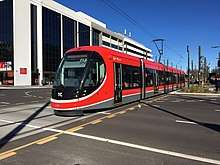 A light rail vehicle departing the Alinga Street terminus | ||||||||||||||||||||||||||||||||||||||||||||||||||||||||||||||||||||||||||||||||||||||||||||||||||||||||||||||||||||||||||||||||||||
| Overview | ||||||||||||||||||||||||||||||||||||||||||||||||||||||||||||||||||||||||||||||||||||||||||||||||||||||||||||||||||||||||||||||||||||
|---|---|---|---|---|---|---|---|---|---|---|---|---|---|---|---|---|---|---|---|---|---|---|---|---|---|---|---|---|---|---|---|---|---|---|---|---|---|---|---|---|---|---|---|---|---|---|---|---|---|---|---|---|---|---|---|---|---|---|---|---|---|---|---|---|---|---|---|---|---|---|---|---|---|---|---|---|---|---|---|---|---|---|---|---|---|---|---|---|---|---|---|---|---|---|---|---|---|---|---|---|---|---|---|---|---|---|---|---|---|---|---|---|---|---|---|---|---|---|---|---|---|---|---|---|---|---|---|---|---|---|---|---|
| Locale | Canberra, Australian Capital Territory | |||||||||||||||||||||||||||||||||||||||||||||||||||||||||||||||||||||||||||||||||||||||||||||||||||||||||||||||||||||||||||||||||||
| Transit type | Light rail | |||||||||||||||||||||||||||||||||||||||||||||||||||||||||||||||||||||||||||||||||||||||||||||||||||||||||||||||||||||||||||||||||||
| Number of lines | 1 | |||||||||||||||||||||||||||||||||||||||||||||||||||||||||||||||||||||||||||||||||||||||||||||||||||||||||||||||||||||||||||||||||||
| Number of stations | 13 | |||||||||||||||||||||||||||||||||||||||||||||||||||||||||||||||||||||||||||||||||||||||||||||||||||||||||||||||||||||||||||||||||||
| Chief executive | Glenn Stockton | |||||||||||||||||||||||||||||||||||||||||||||||||||||||||||||||||||||||||||||||||||||||||||||||||||||||||||||||||||||||||||||||||||
| Headquarters | Mitchell | |||||||||||||||||||||||||||||||||||||||||||||||||||||||||||||||||||||||||||||||||||||||||||||||||||||||||||||||||||||||||||||||||||
| Website | canberra-metro | |||||||||||||||||||||||||||||||||||||||||||||||||||||||||||||||||||||||||||||||||||||||||||||||||||||||||||||||||||||||||||||||||||
| Operation | ||||||||||||||||||||||||||||||||||||||||||||||||||||||||||||||||||||||||||||||||||||||||||||||||||||||||||||||||||||||||||||||||||||
| Began operation | 20 April 2019 | |||||||||||||||||||||||||||||||||||||||||||||||||||||||||||||||||||||||||||||||||||||||||||||||||||||||||||||||||||||||||||||||||||
| Operator(s) | Canberra Metro Operations (CMET)[1][2] | |||||||||||||||||||||||||||||||||||||||||||||||||||||||||||||||||||||||||||||||||||||||||||||||||||||||||||||||||||||||||||||||||||
| Number of vehicles | 14 Urbos 3 trams | |||||||||||||||||||||||||||||||||||||||||||||||||||||||||||||||||||||||||||||||||||||||||||||||||||||||||||||||||||||||||||||||||||
| Train length | 32.96 m (108.1 ft) | |||||||||||||||||||||||||||||||||||||||||||||||||||||||||||||||||||||||||||||||||||||||||||||||||||||||||||||||||||||||||||||||||||
| Headway | 6-15 minutes | |||||||||||||||||||||||||||||||||||||||||||||||||||||||||||||||||||||||||||||||||||||||||||||||||||||||||||||||||||||||||||||||||||
| Technical | ||||||||||||||||||||||||||||||||||||||||||||||||||||||||||||||||||||||||||||||||||||||||||||||||||||||||||||||||||||||||||||||||||||
| Track gauge | 1,435 mm (4 ft 8 1⁄2 in) standard gauge | |||||||||||||||||||||||||||||||||||||||||||||||||||||||||||||||||||||||||||||||||||||||||||||||||||||||||||||||||||||||||||||||||||
| Electrification | 750 V (DC) overhead line | |||||||||||||||||||||||||||||||||||||||||||||||||||||||||||||||||||||||||||||||||||||||||||||||||||||||||||||||||||||||||||||||||||
| Top speed | 70 km/h (43 mph) | |||||||||||||||||||||||||||||||||||||||||||||||||||||||||||||||||||||||||||||||||||||||||||||||||||||||||||||||||||||||||||||||||||
| ||||||||||||||||||||||||||||||||||||||||||||||||||||||||||||||||||||||||||||||||||||||||||||||||||||||||||||||||||||||||||||||||||||
History
Background
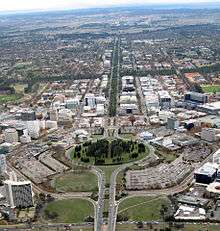
Walter Burley Griffin's master plan for Canberra proposed the construction of a tram network.[3] The proposal did not eventuate and the city was exclusively served by buses from 1926, when the Canberra City Omnibus Service was introduced, until 2019.
While railways across Canberra, including one to Belconnen were seriously considered until the mid-1960s, little discussion of a metropolitan tramway occurred until the 1990s. Prior to 1989, the ACT had been directly administered by the Federal Government thus any large public infrastructure expenditure in Canberra was subject to national scrutiny.
In the early 1990s, Canberra Land proposed a 8.5-kilometre (5.3 mi) line from Canberra Racecourse via Northbourne Avenue to Civic with Melbourne tram B2089 displayed in February 1992.[4]
A light rail connection for Gungahlin was proposed as far back as 1992, when a syndicate of private land developers MBA Land and Consolidated Builders (together known as Canberra Land) incorporated rail into an urban village plan.[5] The Gungahlin proposal followed a 1991 Murdoch University report, Towards a More Sustainable Canberra, which suggested the city was too car-oriented and should implement a light rail system along the Y-Plan.[6] In 1993 a report by Maunsell-Denis Johnston and Associates found that a dedicated inter-town busway was a more viable transport option for Canberra than light rail.[7]
In 1994, the ACT Government commissioned a study into light rail, based on the findings of an independent report that light rail would be viable in Canberra by 1998.[8] In its detailed report consultants Booz Allen Hamilton recommended a route from Belconnen to Barton via the City and Kings Avenue Bridge be operating by 1998; Woden to Barton by 2000; Tuggeranong to Woden by 2002 and Gungahlin to City by 2004. Routes to Canberra Airport and Queanbeyan received a lower priority. By January 1995 the then ACT Liberal Opposition Leader, Kate Carnell, announced her party's opposition to the light rail proposal citing "suspect" patronage figures and questioned the report's projected population for Canberra-Queanbeyan of 474,000 by 2016.[9] Projections in 2017 for the Canberra-Queanbeyan population, forecast the metropolitan area reaching 474,000 between 2020 and 2023, four to seven years later than the 1995 projections.[10][11] In 1995 the ACT Liberal Party came to power and plans for a light rail system in Canberra were dropped.
In February 1998, the ACT Government announced its support for the Federation Line, a proposed 7-kilometre (4.3 mi) line from the National Museum of Australia via Civic to the Australian War Memorial. The line was proposed to use heritage trams.[12]
In September 2001, to try to garner support for the project, Melbourne tram W249 and Sydney tram R2001 were placed on display outside the Australian War Memorial, the latter operating on a 50-metre section of track and being powered by a diesel generator.[13][14] In a further display in September 2003, W249 operated on an 80-metre section of track on Parkes Way.[15][16]
Development
The construction of the light rail line was part of a deal struck between the Labor Party and The Greens following the 2012 Australian Capital Territory Election, at which Labor required Greens support to form government.[17][18] In the 2013/14 ACT budget, $5 million was allocated for early design work.[19] In September 2014, the business case was approved by the government. The project, known as Capital Metro during planning, was developed by the government agency Capital Metro Agency (CMA).
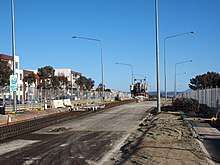
The line was to be delivered under a public private partnership.[20][21] Expressions of interest were received from the following consortia:[22][23]
- ACTivate: Downer Group, Plenary Group, Bombardier and Keolis Downer[24]
- Canberra Metro: Pacific Partnerships, Mitsubishi Corporation, John Holland, CAF, Deutsche Bahn, Aberdeen Asset Management, Leighton Contractors, and Bank of Tokyo-Mitsubishi[25]
- CANGO: Macquarie Capital Group, Obrascon Huarte Lain, SMRT International, UGL Rail and Siemens
- Connecting Canberra: Capella Capital, Transdev, Alstom and Acciona Infrastructure
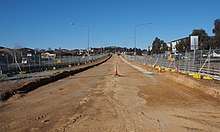
In March 2015, the government announced that ACTivate and Canberra Metro had been selected to move on to the Request for Proposal stage of the procurement process.[26][27] The bidders submitted their final proposals for the Gungahlin to the city route on 4 September and had an additional four weeks to submit their proposals for a potential expansion of the project, from the city to Russell.[28] The Canberra Metro consortium was announced as the preferred tenderer in February 2016 and the contract was finalised in May.[1][29][30] Under the contract, Canberra Metro will operate and maintain the line for 20 years, after which ownership will pass to the ACT Government.[1][31]
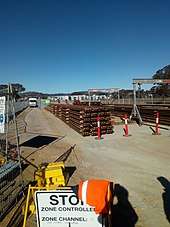
Design and construction costs are budgeted at $707 million.[1] The Federal Government is contributing $67 million to the project.[31] Commencement of construction was marked by a sod-turning in the northern suburb of Mitchell at the site of the depot on 12 July 2016.[32] Major construction of the route itself began towards the end of the year.[33][34][35]
The opposition Liberal Party opposed the project. In April 2015, the party announced it would cancel any contracts for the light rail if it won the 2016 ACT election.[36] A year out from the poll, the light rail project was already predicted to be the election's major issue.[37] As predicted, the light rail project was the major issue of the campaign.[38][39] The election saw the Labor government returned, with the party claiming the result as an endorsement of the project.
The CMA was amalgamated into a new government directorate, the Transport Canberra and City Services Directorate (TCCS), on 1 July 2016, resulting in the responsibility for the project transferred to the TCCS.[40]
Testing of the line began in June 2018. A section in Gungahlin was electrified and one of the trams made trial runs.[41] All 14 trams have arrived in Canberra and it was hoped to have the project completed by the end of 2018.[42] The light rail eventually opened on 20 April 2019.[43][44]
Route


The 12-kilometre (7.5 mi) line has its northern terminus at Hibberson Street in Gungahlin, and follows Flemington Road, the Federal Highway and Northbourne Avenue to the southern terminus between Alinga and Rudd Streets in the City Centre. It is double track for its full length.[1] Emergency crossovers are located to the north of the Dickson Interchange stop, as well as the north of the Nullarbor Avenue stop.[45] There are 13 stops.[46] The main bus interchanges are located at Gungahlin Place, Dickson Interchange and Alinga Street.[1][47]
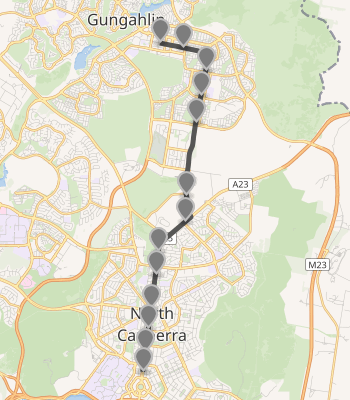
| Stop | Suburb | Platform layout | Coordinates | Refs. |
|---|---|---|---|---|
| Gungahlin Place | Gungahlin | Dual (Island & Side) | 35°11′8.3″S 149°8′7.73″E | [48] |
| Manning Clark North | Gungahlin | Island | 35°11′13.15″S 149°8′36.14″E | [49] |
| Mapleton Avenue | Franklin / Harrison | Island | 35°11′36.17″S 149°9′3.5″E | [50] |
| Nullarbor Avenue | Franklin / Harrison | Island | 35°12′1.98″S 149°8′57.46″E | [51] |
| Well Station Drive | Mitchell | Island | 35°12′29.29″S 149°8′50.96″E | [52] |
| EPIC and Racecourse | Lyneham | Side | 35°13′42.37″S 149°8′39.85″E | [53] |
| Phillip Avenue | Lyneham / Watson | Island | 35°14′8.86″S 149°8′38.14″E | [54] |
| Swinden Street | Lyneham / Downer | Side (staggered) | 35°14′38.89″S 149°8′4.69″E | [55] |
| Dickson Interchange | Lyneham / Dickson | Side | 35°15′2.01″S 149°8′1.46″E | [45] |
| Macarthur Avenue | Lyneham / Dickson | Side | 35°15′36.57″S 149°7′56.02″E | [56] |
| Ipima Street | Turner / Braddon | Side | 35°15′57.23″S 149°7′52.62″E | [57] |
| Elouera Street | Turner / Braddon | Side | 35°16′21.42″S 149°7′48.62″E | [58] |
| Alinga Street | Civic | Side | 35°16′40.56″S 149°7′45.59″E | [59] |
Another stop is planned to be built on Flemington Road in Mitchell.[60]
Operation

The service is operated by Canberra Metro Operations (CMET), in association with Deutsche Bahn Engineering and Consulting, under a 20 year contract.[1][2] CMET is a joint venture between John Holland and Pacific Partnerships, both of whom are part of the Canberra Metro consortium.
CMET holds the contract to operate the light rail until at least 2036.[61]:p. 1[62] Formed in 2016,[63] it is a partnership between John Holland and Pacific Partnerships in association with Deutsche Bahn Engineering and Consulting.[61]:p. 12 CMET commenced operations on April 20th, 2019 with the completion of the first stage of the project.[64]
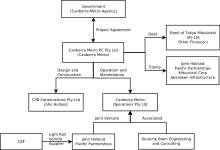
CMET is part of the Canberra Metro Consortium, acting as the operations component of the group, with both its owners also being equity providers.[61]:p. 12 CMET does not actually contract with the ACT Government, rather it contracts with Canberra Metro PC Pty Limited (Canberra Metro) to provide service on its lines, who then contract with the Canberra Metro Agency to manage the project and provide services to the city.[61]:p. 3
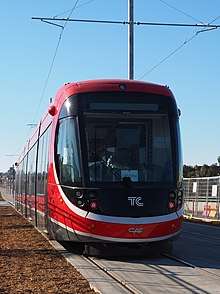
The contract specifies the following minimum service levels for hours of operation and service frequency:[1]
| Day | First service | Last service |
|---|---|---|
| Monday to Thursday | 06:00 | 23:30 |
| Friday and Saturday | 06:00 | 01:00 the following day |
| Sunday | 08:00 | 23:30 |
| The last services from Gungahlin depart half an hour earlier. The first service from the city on Sunday departs half an hour later. | ||
| Day | Departure time | Frequency | |
|---|---|---|---|
| To the city | To Gungahlin | ||
| Monday to Friday | 06:00-07:00 | 15 minutes | 15 minutes |
| Monday to Friday | 07:00-07:30 | 6 minutes | 10 minutes |
| Monday to Friday | 07:30-09:00 | 6 minutes | 6 minutes |
| Monday to Friday | 09:00-16:00 | 10 minutes | 10 minutes |
| Monday to Friday | 16:00-17:30 | 6 minutes | 6 minutes |
| Monday to Friday | 17:30-18:00 | 10 minutes | 6 minutes |
| Monday to Friday | After 18:00 | 15 minutes | 15 minutes |
| Saturday | 06:00-01:00 | 15 minutes | 15 minutes |
| Sunday | 08:00-23:00 | 15 minutes | 15 minutes |
Rolling stock
CAF built 14 Urbos 3 trams to operate the system. It will also provide twenty years of maintenance for the fleet.[65][66] The trams are 32.96 m (108 ft 1.64 in) long and consist of five modules. There are four doors on each side of the vehicle, two single leaf and two double leaf doors.[67] The first tram was delivered in December 2017.[68][69][70] The vehicles feature a red and grey livery, with white reflective stripe in the middle.[71] The depot is located in Mitchell.[72]
Control system
Tehnika's t-visor RAIL platform, also used on the Gold Coast Light Rail[73], provides the operators with a single, centralised control system. This encompasses the automatic vehicle location, traffic signalling priority, traction power & infrastructure SCADA, CCTV and passenger information systems, amongst others.[74]
Potential extensions

The consortia participating in the procurement process for the initial line were asked to develop plans for an expanded route from the City Centre to the Defence headquarters in Russell via London Circuit and Constitution Avenue. This additional 3.2-kilometre (2 mi) section was estimated to boost the patronage of the line as a whole by more than 30%. The proposal highlighted the desire of the Federal Government's National Capital Authority to use wire-free technology to power the trams in areas of the city under the authority's management.[75][76] The ACT Government decided not to proceed with the expanded route, but committed to releasing a plan for a second stage of the light rail network prior to the October 2016 territory election. It was considering extending the line not only to Russell but to the broader parliamentary triangle, possibly including Canberra Airport and the Australian National University.[77]
Stage 2: Civic to Woden
In July 2016, the government released a shortlist of four potential routes that could form the second stage of the light rail network. The routes were:[78]
- City to Canberra Airport via Constitution Avenue & Parkes Way
- City to Belconnen Town Centre via Barry Drive past Calvary Hospital & the University of Canberra
- City to the Parliamentary Triangle via either Commonwealth Avenue or Kings Avenue
- City to Mawson via Woden.
In September 2016, the government selected a truncated version of the Mawson route that ends at Woden as its preferred second stage project. The route is around 11 kilometres (6.8 mi) long.[79][80] Tenders to design various aspects of the project were called in November. At that stage the only firm decisions the government had made about the route were that it would run from Alinga Street to the Woden Town Centre and use the Commonwealth Avenue Bridge to cross Lake Burley Griffin.[81] More concrete plans were released in May 2017. South of Lake Burley Griffin, the route will predominantly travel via Adelaide Avenue and Yarra Glen. Design options for several sections of the route that had yet to be locked in were presented to the public for comment.[82][83] An option that would have extended the route to the Canberra Hospital was dropped in December 2017.
There were two options for the section between Lake Burley Griffin and Adelaide Avenue: a deviation to Barton with proposed stops at Old Parliament House, Brisbane Avenue and Sydney Avenue; or a more direct route via the Capital Circle.[84] The longer route via Barton was selected by the ACT Government as the preferred route in April 2018.[85] In March 2019 the Commonwealth Government offered its support for the extension to Woden, however it favoured a different path around Capital Hill, arguing for a route along the State Circle.[86] A delay in the federal government response meant planning work for the line was postponed, though choosing to not pursue the Barton route could mean a simpler regulatory process.[86] The ACT Government is now investigating the State Circle route, which involves some technical challenges due to steep gradients for light rail.[87]
When construction of stage 1 began, construction of stage 2 was planned to begin shortly after the completion of the first stage.[81] The Federal Government will be invited to make a contribution to the project as part of the government's City Deals program.[88]
In July 2019 the new ACT Transport minister Chris Steele announced that stage 2 would be divided into 2 parts, 2A to stop before Lake Burley Griffin at Commonwealth Park and 2B to continue across the lake to Woden.[89]
In mid July 2019 the ACT Government submitted a referral to the Australian Department of Environment and Energy for stage 2A, covering the extension from Civic to Commonwealth Park as well as an expansion of the depot in Mitchell.[90] In September the ACT Government approved the business case for stage 2A, confirming the three new stops on the route which will also require London Circuit being raised at Commonwealth Avenue where the light rail will travel.[91] According to the business case stage 2A from the Alinga street stop to the Commonwealth Park Stop will be about 6 minutes.[92]
In mid July 2019 the ACT Government submitted a referral to the Australian Department of Environment and Energy for stage 2B, covering the extension from Commonwealth Park to Woden.[93]
Stage 3: Belconnen to Canberra Airport
In October 2019 the ACT Government released its infrastructure plan which included stage 3 of light rail going from Belconnen to Canberra Airport via Civic, with the Civic–Belconnen section built first.[94][95]
Stage 4: Woden to Tuggeranong
In October 2019 the ACT Government released its infrastructure plan which included stage 4 extending from Woden to Tuggeranong via Mawson.[95]
Twenty-five year vision
In October 2015, the ACT Government released a plan for a citywide light rail network that would be built over a period of twenty-five years.[96] The plan includes the following elements:[97]
| Corridor | Notes |
|---|---|
| Gungahlin to City | Stage One; complete. |
| Parliamentary Triangle | Connecting City to Russell, City to the Parliamentary Zone and Russell to the Parliamentary Zone. High priority corridor. |
| Woden to City | Running via Adelaide Avenue. High priority corridor. |
| Tuggeranong to Woden (Athllon Corridor) | Running either via the Athllon Drive Corridor or the existing rapid bus alignment along Erindale Drive |
| Eastern connections (Fyshwick and Canberra Airport) | Additions to the Parliamentary Triangle routes, from Russell to Canberra Airport and the Parliamentary Zone to Fyshwick. High priority corridor. |
| Belconnen to City | Running via Southern Cross Drive and Barry Drive |
| Molonglo to City | Woden to City via Hindmarsh Drive, John Gorton Drive and Parkes Way |
References
- "Capital Metro Contract Summary" (PDF). Transport Canberra and City Services. Archived (PDF) from the original on 21 March 2019. Retrieved 20 April 2019.
- "Corrs Advises Pacific Partnerships And John Holland On Canberra's Light Rail Project". Corrs Chambers Westgarth Laweyers. 24 February 2016. Archived from the original on 20 March 2019. Retrieved 20 April 2019.
- "The Canberra Legacy: Griffin, Government and the Future of Strategic Planning in the National Capital" (PDF). Be.unsw.edu.au. p. 26. Retrieved 8 March 2015.
- "Canberra" Trolley Wire issue 249 May 1992 page 21
- Sibley, David (13 October 1992). "Our city's future, and $337m windfall". The Canberra Times. Retrieved 12 June 2017.
- Hobbs, Philip (18 May 1991). "Light rail needed to reduce ACT traffic". The Canberra Times. Retrieved 12 June 2017.
- Clack, Peter (3 September 1993). "Buses beat light rail, says report". The Canberra Times. Retrieved 12 June 2017.
- Downie, Graham (21 December 1994). "Govt pays fare for next light rail trip". The Canberra Times. Retrieved 12 June 2017.
- Hull, Crispin (4 January 1995). "Light-rail to costly for ACT, say Libs". The Canberra Times. Retrieved 13 June 2017.
- Burgess, Kate (14 March 2017). "ACT's population projected to hit 421,000 by 2020". The Canberra Times. Retrieved 13 June 2017.
- "Queanbeyan (C) (LGA)". Australian Bureau of Statistics. Retrieved 13 June 2017.
- "Heritage Tramway proposed for Canberra" Trolley Wire issue 272 February 1998 page 16
- Canberra trams Railway Gazette International 1 October 2001
- "First Tram Runs in Canberra" Trolley Wire issue 287 November 2001 page 3
- "A W2 runs in Canberra" Trolley Wire issue 295 November 2003 pages 8-11
- September 2001: Trams displayed at the Australian War Museum The Federation Line
- "Parliamentary Agreement for the 8th Legislative Assembly for the Australian Capital Territory" ACT Greens 2 November 2012
- Canberrans not completely on board light rail project: poll Canberra Times 3 August 2014
- "Canberra light rail funding included in budget". Railway Gazette International. 10 June 2013. Retrieved 11 June 2013.
- A Public Private Partnership for Canberra Metro Archived 2014-11-29 at the Wayback Machine Capital Metro
- Canberra light rail project moves ahead after business case approved ABC News 16 September 2014
- Carter, Mark (24 December 2014). "Bidders line up for Canberra LRT tender". International Railway Journal.
- Major companies vying for chance to build ACT light rail network, ABC News Online, 22 December 2014, accessed 1 February 2016
- Consortium members ACTivate Canberra
- John Holland to deliver Canberra light rail project John Holland 17 May 2016
- Barrow, Keith (19 March 2015). "Two bidders shortlisted for Canberra LRT". International Railway Journal.
- "Preferred consortia announced for light rail project". ACT Government. Archived from the original on 1 April 2015. Retrieved 20 March 2015.
- Belot, Henry (4 September 2015). "Canberra light rail hopefuls submit final bid papers for $783 million contract". The Canberra Times.
- Canberra Metro selected to build stage one of light rail from Gungahlin to the city ABC News 1 February 2016
- Capita Metro named as successful light rail consortium Archived 2016-02-29 at the Wayback Machine Canberra Metro 1 February 2016
- "Contracts signed for Canberra's first light rail project". Capital Metro. 17 May 2016.
- Sibthorpe, Clare (12 July 2016). "Construction begins on ACT light rail depot at Mitchell". The Canberra Times.
- Canberra light rail contract signed Railway Gazette International 18 May 2016
- Budget 2017: Extra safety inspectors announced for Canberra light rail Canberra Times 3 June 2017
- Burgess, Katie (26 October 2018). "Canberra's light rail won't take passengers until 2019". The Canberra Times. Retrieved 7 November 2018.
- "Light rail contract 'will be torn up' if the Canberra Liberals win 2016 ACT election". ABC News. 15 April 2015. Retrieved 15 April 2015.
- "Light rail will dominate next year's ACT election. Both main parties have more explaining to do". The Canberra Times. 11 October 2015.
- Knaus, Christopher (15 October 2016). "Election win shows comprehensive support for light rail". The Canberra Times.
- "ACT election: Labor Chief Minister Andrew Barr claims victory, says Canberra has voted for light rail". ABC News. 15 October 2016. Retrieved 15 October 2016.
- "Transport Canberra and City Services: Annual Report 2016-17 Volume 1" (PDF). Transport Canberra and City Services Directorate. Archived (PDF) from the original on 21 March 2019. Retrieved 21 April 2019.
- Burgess, Katie (12 June 2018). "In dead of night, Canberra's light rail vehicle emerges for testing". The Canberra Times. Retrieved 15 July 2018.
- Canberra's last light rail vehicle arrives Canberra Times 27 September 2018
- Burgess, Kate (19 March 2019). "Start date revealed for Canberra's light rail system". The Canberra Times. Retrieved 19 March 2019.
- Canberra light rail delivered in time for Easter launch UGL 23 April 2019
- "Capital Metro - Canberra's light rail: design drawings" (PDF). Arup/Hassell/Parsons Brinkerhoff/Capital Metro Agency. pp. 32, 33. Retrieved 17 October 2016.
- "Routes and Stops". Transport Canberra. Archived from the original on 18 October 2016. Retrieved 17 October 2016.
- "Light Rail Stage 1 takes shape as stop names announced". Transport Canberra. Archived from the original on 14 April 2018. Retrieved 5 May 2017.
- "Capital Metro - Canberra's light rail: design drawings" (PDF). Arup/Hassell/Parsons Brinkerhoff/Capital Metro Agency. p. 8. Retrieved 17 October 2016.
- "Capital Metro - Canberra's light rail: design drawings" (PDF). Arup/Hassell/Parsons Brinkerhoff/Capital Metro Agency. p. 10. Retrieved 17 October 2016.
- "Capital Metro - Canberra's light rail: design drawings" (PDF). Arup/Hassell/Parsons Brinkerhoff/Capital Metro Agency. p. 13. Retrieved 17 October 2016.
- "Capital Metro - Canberra's light rail: design drawings" (PDF). Arup/Hassell/Parsons Brinkerhoff/Capital Metro Agency. pp. 15, 16. Retrieved 17 October 2016.
- "Capital Metro - Canberra's light rail: design drawings" (PDF). Arup/Hassell/Parsons Brinkerhoff/Capital Metro Agency. p. 43. Retrieved 17 October 2016.
- "Capital Metro - Canberra's light rail: design drawings" (PDF). Arup/Hassell/Parsons Brinkerhoff/Capital Metro Agency. p. 25. Retrieved 17 October 2016.
- "Capital Metro - Canberra's light rail: design drawings" (PDF). Arup/Hassell/Parsons Brinkerhoff/Capital Metro Agency. p. 27. Retrieved 17 October 2016.
- "Capital Metro - Canberra's light rail: design drawings" (PDF). Arup/Hassell/Parsons Brinkerhoff/Capital Metro Agency. p. 44. Retrieved 17 October 2016.
- "Capital Metro - Canberra's light rail: design drawings" (PDF). Arup/Hassell/Parsons Brinkerhoff/Capital Metro Agency. p. 36. Retrieved 17 October 2016.
- "Capital Metro - Canberra's light rail: design drawings" (PDF). Arup/Hassell/Parsons Brinkerhoff/Capital Metro Agency. p. 37. Retrieved 17 October 2016.
- "Capital Metro - Canberra's light rail: design drawings" (PDF). Arup/Hassell/Parsons Brinkerhoff/Capital Metro Agency. p. 40. Retrieved 17 October 2016.
- "Capital Metro - Canberra's light rail: design drawings" (PDF). Arup/Hassell/Parsons Brinkerhoff/Capital Metro Agency. p. 41. Retrieved 17 October 2016.
- Brewer, Peter (4 June 2019). "More buses arriving and Mitchell lands a second light rail stop". The Canberra Times. Australian Community Media. Retrieved 8 November 2019.
- Capital Metro Agency (1 June 2016). "Capital Metro Contract Summary" (PDF). Transport Canberra City Services. Retrieved 21 December 2019.
- "Canberra Light Rail". www.pacificpartnerships.com.au. Retrieved 20 December 2019.
- ASIC Company Registry; ACN 612 397 485
- Hitch, Georgia (20 April 2019). "Canberra's light rail welcomes its first official passengers". ABC News. Retrieved 20 December 2019.
- "Canberra Metro named as successful light rail consortium". ACT Government. Archived from the original on 1 April 2016. Retrieved 26 March 2016.
- "CAF to deliver Capital Metro Trams" Railway Digest September 2016 page 4
- "CAF awarded the supply of Canberra trams, in Australia". Construcciones y Auxiliar de Ferrocarriles. 1 February 2016.
- First tram gets police escort into Canberra under the cover of darkness Canberra Times 14 December 2017
- First tram arrives in Canberra Metro Report International 15 December 2017
- A century late, Canberra gets its first tram Rail Express 15 December 2017
- New ACTION buses to be blue, light rail trams to be red Archived 2016-12-20 at the Wayback Machine Canberra Times 14 December 2016
- "Nuts and bolts". ACT Government. Archived from the original on 22 March 2016. Retrieved 26 March 2016.
- "Light Rail Innovation | News & Insights". Informa Australia. 10 February 2017. Retrieved 28 May 2020.
- Writer, Staff (24 February 2020). "One-stop-shop for LRV operations". Rail Express. Retrieved 28 May 2020.
- Carter, Mark (9 February 2015). "Canberra expands light rail project". International Railway Journal.
- McIlroy, Tom (10 September 2015). "Underground power plan for Russell light rail extension". The Canberra Times.
- Knaus, Christopher (7 June 2016). "ACT Budget 2016: Budget shows 'rubbish' claims on tram cost, chief minister says". The Canberra Times.
- Lawson, Kirsten (21 July 2016). "Labor announces possible Canberra light rail extensions to build in next term of government". The Canberra Times.
- Knaus, Christopher (2 September 2016). "Labor announces light rail to go to Woden". The Canberra Times.
- "Canberra light rail's second stage to link Woden and Civic, ACT Government says". ABC News. Australian Broadcasting Corporation. 2 September 2016.
- Lawson, Kirsten (25 November 2016). "Serious work to begin on Woden light rail line as ACT government calls tenders on design and cost". The Canberra Times.
- Scott, Elise (1 May 2017). "Could Canberra's light rail head to Barton instead of Parliament House?". ABC News. Australian Broadcasting Corporation.
- Kirsten, Lawson (2 May 2017). "Canberra light rail: Options for stage two route to Woden revealed". The Canberra Times. Retrieved 10 April 2018.
- Burgess, Katie (19 December 2017). "Canberra Hospital extension officially dropped for stage two of light rail". The Canberra Times. Retrieved 10 April 2018.
- Trask, Steven (19 April 2018). "ACT government announces preferred stage two light rail route". The Canberra Times. Retrieved 19 April 2018.
- Burgess, Katie (7 March 2019). "Commonwealth backs State Circle route for light rail stage two". The Canberra Times. Retrieved 27 April 2019.
- Burgess, Katie (17 December 2018). "Steep gradient poses technical challenge to State Circle alignment". The Canberra Times. Retrieved 27 April 2019.
- "ACT light rail funding to be discussed at 'City Deals' meeting with Prime Minister". ABC News. Australian Broadcasting Corporation. 9 November 2016.
- Ian Bushnell (5 July 2019). "Light rail Stage 2 split in two in bid for faster approval". RiotACT. Region Group Pty Ltd. Retrieved 17 September 2019.
- "CMTEDD ACT PROCUREMENT/Transport - Land/Northbourne Ave, Mitchell Depot, London Cct, Commonwealth Ave/Australian Capital Territory/City to Commonwealth Park Light Rail Project, ACT". Department of the Environment and Energy. Retrieved 17 September 2019.
- Hayne, Jordan (10 September 2019). "Canberra light rail's business plan for Stage 2A approved by ACT Government, London Circuit to be raised". ABC.net.au. Australian Broadcasting Corporation. Retrieved 17 September 2019.
- Major Projects Canberra (August 2019). "City to Woden Light Rail: Stage 2A City to Commonwealth Park Business Case" (PDF). Transport Canberra. ACT Government. Retrieved 17 September 2019.
- "CMTEDD ACT PROCUREMENT/Transport - Land/Road reserves of Commonwealth Ave, State Circle, Adelaide Ave, Yarra Glen and Callam St/Australian Capital Territory/Commonwealth Park to Woden Light Rail Project, ACT". Department of the Environment and Energy. Retrieved 17 September 2019.
- Bushnell, Ian (17 October 2019). "Belco, Airport and Tuggeranong next stops for Canberra's light rail journey". RiotACT. Region Group Pty Ltd. Retrieved 8 November 2019.
- "Infrastructure Plan" (PDF). ACT Treasury. ACT Government. Retrieved 8 November 2019.
- McIlroy, Tom (26 October 2015). "Woden and Parliament next for light rail lines in Canberra tram master plan". The Canberra Times.
- "Light Rail Network - Delivering a modern transport system for a growing city". ACT Government/Trove. 2015. Retrieved 18 June 2019.